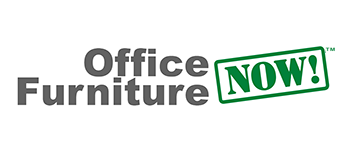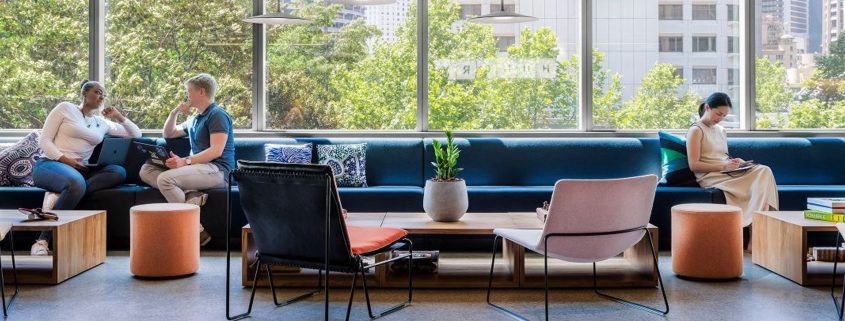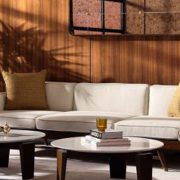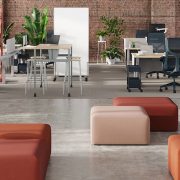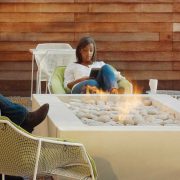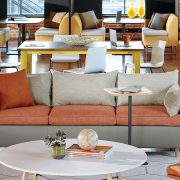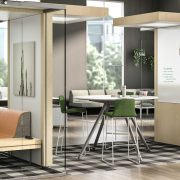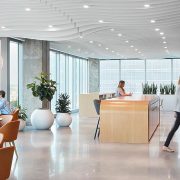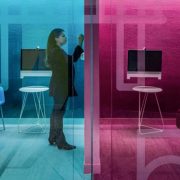Hospitality Design At Work
Hospitality design at work builds upon the premise of re-establishing the importance of strengthening the community workplaces provide. It has been the top influencer behind destination design which is driving the return to work. This rising star made a name for itself with the experiential design trend found in coworking spaces.
Many workplaces are striving to evolve quickly. So designers are continuing to adapt by taking pertinent clues from survey data. According to PwC’s remote work survey, 87% of employees agree that a presence in the office is important for collaborating with team members and building relationships. According to the Society for Human Resource Management, maintaining employee morale and engagement has become the top priority over the past year.
BUILDING COMMUNITY
To grasp the importance of hospitality design at work, we need to understand how the return to work for flexible workers affects behavior and productivity. Many workers felt more productive at home within an environment they could control. Hybrid working strives to offer employees choices and more freedom in how and where they work. As a result, forward-thinking companies are seeking innovative ways to bring people back together.
Hospitality design captures attention by connecting people with places. Think about the significant experiences and destinations that lure you back again and again. What is it about these places that captivates, holds your attention, and makes you want to return to linger in a specific space or location?
Pivoting a workplace into linger mode is where the sweet spot of hospitality design resides. Alongside the need for a range of flexible areas for individuals, collaborative work, and shared experiences connecting your teams.
CREATING COMFORTABLE
Employers hoping, expecting, or demanding that knowledge workers come back to the office are asking designers to make their workplaces more exceptional to entice their team back into the office. How do you achieve that? By focusing on an exceptional experience and crafting:
A design plan that creates casual comfort by integrating touches of residential with modern hospitality design. Many large companies schedule annual retreats to allow teams in other locations to converge and connect through shared experiences, and workshops in recreational settings. Think about which of these destination spaces captured and held their attention the longest.
A reception area that creates intrigue. If your reception area is outdated, intimidating, and formal, focus on creating a more vibrant connection with a concierge station that replicates the welcoming and exciting experience of walking into that hotel lobby.
Re-visualizing a space plan that provides a variety of soft furnishings set in conversational layouts. Mix in activity spaces that include food and beverage stations. Focus on easy connection points, both inside the office and via digital connectivity, within highly productive and functional work areas that provide a variety of seating options.
Furniture selection + arrangement are vital to setting the stage for human comfort and wellbeing, as well as workplace productivity. Residential design in the workplace provides a more relaxed setting, and it can make the transition between working from home more accessible. Casual lounge settings offer employees the opportunity to reset throughout the day and residential-inspired lighting can create a more intimate ambiance and define specialty areas.
THE PIVOT
Focusing on a design strategy that fits both flex and on-site teams, as well as clients who visit your workspace frequently, includes some similarities that make connecting in a memorable environment something to look forward to. Overlapping trends include but are not limited to:
- A “work anywhere” concept, set within a social hub atmosphere in the office, provides more open shared spaces with fewer private spaces.
- Social hubs featuring flexible, multipurpose rooms with ancillary furniture that encourage people to connect and create more collaboration and social connections.
- A quality of space that becomes more boutique, fun, casual, quiet, and comfortable.
- A shift of focus from the employer to the employee, with an eye on employee health/wellness and concierge-type services to compete for talent and create employee brand loyalty.
- Biophilic design to reduce stress and help promote renewal at work. Infusing natural elements like living walls into corridors, entries, and conference areas revitalizes. Terrace workspaces have become a focal point in hotel destination design.
- Incorporate local flavor that pays homage to the community and represents how your brand fits into the daily lives of your locale.
- Inject neighborhood connectivity which puts people nearer to services, their homes, and walkable areas. The buildings themselves have to function differently and provide space for people to fluidly communicate.
TAKEAWAYS
- Hospitality-inspired office design elevates the brand and employee experience by enhancing connection, wellbeing, and productivity.
- Pivoting to the more relaxed feeling of hospitality design helps businesses better respond to the diverse needs of their employees.
- A more welcoming office environment can serve as a tool for supporting connection, a sense of community, and inclusivity.
- Hospitality design encourages businesses to futureproof a more desirable workplace culture, build employee loyalty and attract talent.
- Flexible working naturally fits into a hospitality-inspired office design and blurs the comfort and familiarity of home with the office, and everything in between.
By designing more welcoming spaces that push the boundaries of what the future workplace should be, we can continue to support businesses that want to achieve their goals, inspire their people, and build greater human connections at work. Our team can guide you through these changes and help you achieve a more community-focused workplace.
 OUR PROJECT MANAGEMENT TEAM can help you discover, prioritize and visualize these changes with a variety of tools and methodologies to assist with design upgrades and reconfigurations. Contact our sales team for guidance at 512-448-3769 or experts@officefurniturenow.com
OUR PROJECT MANAGEMENT TEAM can help you discover, prioritize and visualize these changes with a variety of tools and methodologies to assist with design upgrades and reconfigurations. Contact our sales team for guidance at 512-448-3769 or experts@officefurniturenow.com
